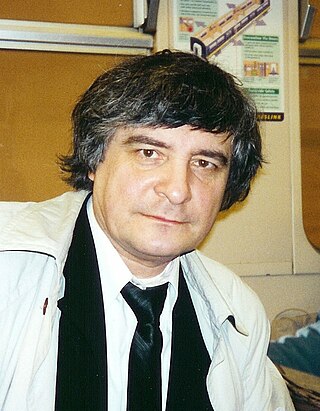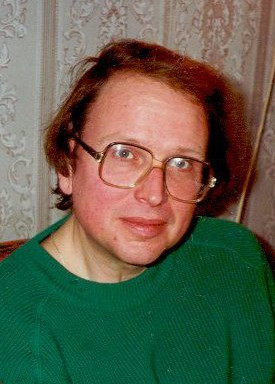Related Research Articles

Alfred Garrievich Schnittke was a Russian composer of Jewish-German descent. Among the most performed and recorded composers of late 20th-century classical music, he is described by musicologist Ivan Moody as a "composer who was concerned in his music to depict the moral and spiritual struggles of contemporary man in [...] depth and detail."

The Symphony No. 15 in A major, Op. 141, composed between late 1970 and July 29, 1971, is the final symphony by Dmitri Shostakovich. It was his first purely instrumental and non-programmatic symphony since the Tenth from 1953. Shostakovich began to plan and sketch the Fifteenth in late 1970, with the intention of composing for himself a cheerful work to mark his 65th birthday the next year. After completing the sketch score in April 1971, he wrote the orchestral score in June while receiving medical treatment in the town of Kurgan. The symphony was completed the following month at his summer dacha in Repino. This was followed by a prolonged period of creative inactivity which did not end until the composition of the Fourteenth Quartet in 1973.
The Cello Concerto No. 1 in E-flat major, Op. 107, was composed in 1959 by Dmitri Shostakovich. Shostakovich wrote the work for his friend Mstislav Rostropovich, who committed it to memory in four days. He premiered it on October 4, 1959, at the Large Hall of the Leningrad Conservatory with the Leningrad Philharmonic Orchestra conducted by Yevgeny Mravinsky. The first recording was made in two days following the premiere by Rostropovich and the Moscow Philharmonic Orchestra conducted by Aleksandr Gauk.

Gennady Nikolayevich Rozhdestvensky, CBE was a Soviet and Russian conductor.

Dmitri Nikolaevich Smirnov was a Russian-British composer and academic teacher, who also published as Dmitri N. Smirnov and D. Smirnov-Sadovsky. He wrote operas, symphonies, string quartets and other chamber music, and vocal music from song to oratorio. Many of his works were inspired by the art of William Blake.

Elena Olegovna Firsova is a Russian composer.
The Concerto in C minor for Piano, Trumpet, and String Orchestra, Op. 35, was completed by Dmitri Shostakovich in 1933.
Boris Berman is a Russian pianist and pedagogue.
Alexander Mikhailovich Raskatov is a Russian composer.
The Symphony No. 9 by Alfred Schnittke was written two years before his death in 1998. As a result of paralysis following a series of strokes, the manuscript was barely readable, and a performing edition was made by Gennady Rozhdestvensky. Schnittke was dissatisfied with Rozhdestvensky's edition, and following his death his widow Irina Schnittke sought to have a reconstruction made that was more faithful to the manuscript. Nikolai Korndorf was first engaged to perform the task, and following his early death the manuscript was passed to Alexander Raskatov. Raskatov not only reconstructed Schnittke's Ninth but also wrote his own composition: Nunc dimittis – In memoriam Alfred Schnittke, which was performed after the symphony in the premiere recording conducted by Dennis Russell Davies.

Alexander Ivashkin, was a Russian cellist, writer, academic and conductor.
The Third Symphony by Alfred Schnittke was his fourth composition in the symphonic form, completed in 1981.
The Concerto Grosso No. 1 was the first of six concerti grossi by Soviet composer Alfred Schnittke. It was written in 1976–1977 at the request of Gidon Kremer and Tatiana Grindenko who were also the violin soloists at its premiere on 21 March 1977 in Leningrad together with Yuri Smirnov on keyboard instruments and the Leningrad Chamber Orchestra under Eri Klas. It is one of the best-known of Schnittke's polystylistic compositions and marked his break-through in the West.
Symphony No. 0 by Russian composer Alfred Schnittke was composed in 1956–57 whilst Schnittke was a student at the Moscow Conservatory. It was given its first performance in 1957 by the Moscow Conservatory Symphony Orchestra conducted by Algis Zhiuratis. Present at the premiere were Dmitri Shostakovich and Dmitry Kabalevsky.
Symphony No. 6 by Russian composer Alfred Schnittke was composed in 1992. It was commissioned by cellist and conductor Mstislav Rostropovich and the National Symphony Orchestra of Washington, who together gave its first performance in Moscow on 25 September 1993.
Russian composer Alfred Schnittke's Symphony No. 8 was composed in 1994. Its dedicatee Gennady Rozhdestvensky conducted the Royal Stockholm Philharmonic Orchestra in the symphony's premiere in Stockholm on 10 November 1994.
Alfred Schnittke composed his Concerto Grosso No. 3 for two violins, harpsichord, piano, and celesta in 1985.

October, Op. 131, is a symphonic poem composed by Dmitri Shostakovich to commemorate the fiftieth anniversary of the October Revolution in 1967. He was spurred to compose the work after reencountering his score for the Vasilyev brothers' 1937 film Volochayev Days, reusing its "Partisan Song" in October. Although Shostakovich completed the work quickly, the process of writing it fatigued him physically because of his deteriorating motor functions.
The Piano Quintet by Alfred Schnittke is a five-movement work for piano and string quartet composed 1972–1976. It was later arranged for symphony orchestra at the request of Gennady Rozhdestvensky and retitled In Memoriam...
References
- 1 2 3 Demchenko 2015, p. 63.
- 1 2 Kislitsyna 2018, p. 35.
- 1 2 3 Schmelz 2020, p. 173.
- ↑ Ivashkin 2002, p. xxii.
- ↑ Kislitsyna 2018, pp. 63–64.
- 1 2 Kislitsyna 2018, p. 36.
- 1 2 3 "Concerto for Piano and String Orchestra". Sikorski. 2022. Retrieved 28 October 2022.
- 1 2 Ivashkin 2014, p. 267.
- ↑ Kislitsyna 2018, p. 37.
- 1 2 3 4 Morgan, Dan (April 2009). "Alfred Schnittke (1934-1998) / Piano Concertos". musicweb-international.com. Retrieved 28 October 2022.
- ↑ "Alfred Schnittke". prestomusic.com. 2022. Retrieved 3 November 2022.
- ↑ Distler, Jed. "Shostakovich & Schnittke Concertos". classicstoday.com. Retrieved 3 November 2022.
- ↑ "Schnittke - Concerto for Piano and Strings". prestomusic.com. 2022. Retrieved 3 November 2022.